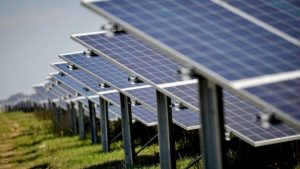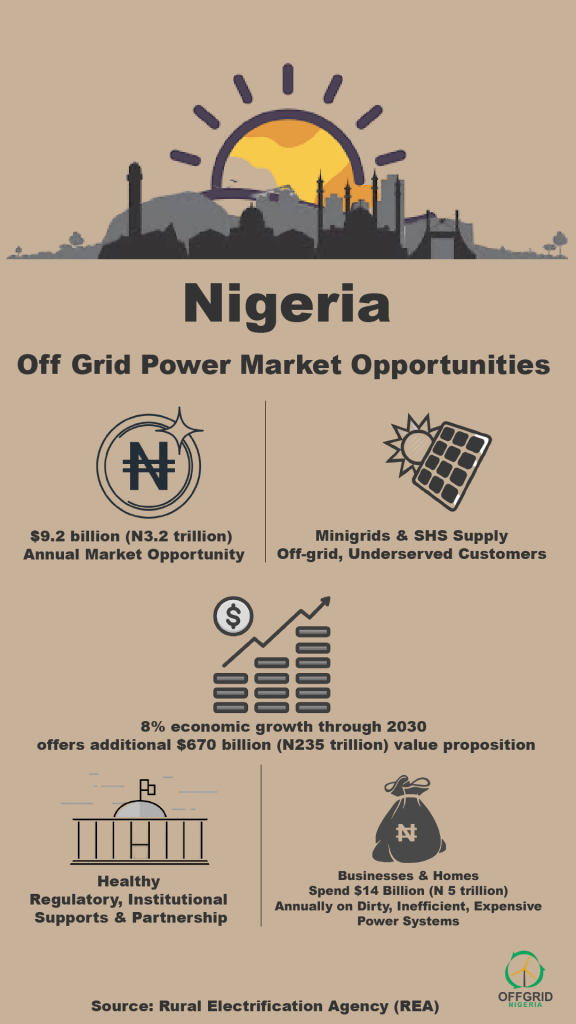It is quite out-of-date to report that Nigeria does not produce enough electricity to satisfy the demands of about 40 per cent of its population who are reportedly connected to her national grid.
Every day, millions of people in this bracket, who occupy her homes, or work in her offices and industries have to share from the average 3500 megawatts of electricity she generates from her gas and large hydro plants.
In fact, with her rich gas and hydro resources, Nigeria has never produced more than 5074 megawatts of electricity for this huge number of people connected to the grid.
But beyond those ‘fortunate’ to get electricity from the grid, there are about 96 million people in rural schools, cottage hospitals and even farm settlements who are not connected to the grid, may not be connected for a long time, but need electricity.
For people in this bracket, the government of Nigeria has promised to reach them by 2020 and 2030, though with no concrete action plan to buttress the promise.
Tied to the ‘business as usual’ attitude and expensive requirements for grid expansion, the government’s pledge to cut down the number of Nigerians without electricity looks quite idealistic.
However, there are alternatives which are not entirely new but have been refined and can help Nigeria achieve its proposal if properly applied. These alternatives are decentralised renewable energy technologies, and they include solar, wind, biomass, small hydros and geothermal.
According to Power for All, an international advocacy group for decentralised Renewable Energy (RE), these technologies are faster and affordable alternatives to guaranteeing access to electricity and will be suitable to give electricity to Nigeria’s unserved population.
Besides Nigeria’s unique advantage possessing very good amount of these RE sources, the fact that their respective technologies are growing in leaps across the globe makes it vital that she adopts them.
What is renewable energy?
To make it modest and real, renewable or sustainable energy is any energy derived from an inexhaustible supply of naturally occurring fuel, though some like biomass are quite finite. There are several types of sustainable energy – Hydro, Geothermal, Wind, Solar and Biomass broadly categorise them.
Renewables are not entirely a new concept because many civilizations started harnessing the powers of sustainable energy to achieve tasks in semi mechanized systems. Wind mills in Europe and water mills in Asia were used to power non electrical machines and performed their duties efficiently for the most part.
Today the global call for a return to renewable energy is spearheaded primarily to counteract our self-inflicted injury of global warming, and to speedily deliver power to the poorest parts of the world.
Renewable energy is easier and faster to install, cheaper to maintain (most times) and generally much adaptive to whatever environment it is placed in, plus research and development have substantially reduced the price of the technology and still promises to further cut down on the cost of deployment.
Due to the diverse energy generating options available, many pundits propound that every part of the earth can generate one sustainable power or the other. But here, Nigeria is lucky to have most of it.
Here are five renewable sources we found the country can quickly deploy to give electricity to millions of her homes, and then exit the inglorious list of countries with abject energy poverty.
HYDROELECTRIC POWER
Hydro power presents some of the more efficient and cheaper means of generating power, using water pressure to turn turbines. Nigeria currently operates three known hydroelectric stations – the Kainji, Shiroro and Jebba stations with a combined potential output of about 2000MW.
Noteworthy also is the Mambilla plant, which will be constructed starting from the end of 2016 as recently promised by President Muhammadu Buhari. Mambilla will give out 3050MW of hydroelectricity when completed.
There are also small rivers across the country which can have small hydro plants installed by them to power rural homes, hospitals, schools and farm settlements.
Nigeria being a coastal country is also availed the opportunity to harness the tides using tidal power generating technology.
SOLAR
Solar energy, which is energy gotten from the sun and converted into electricity, can be generated in two ways; the photovoltaic and the solar thermal energy process. The first converts the sun’s energy into electricity and the second converts it into heat.
Nigeria has seen a recent upsurge in solar power usage, especially to augment grid provided electricity which can be erratic, however there is no contribution yet by solar in the national grid, and no decent statistics actually measuring its consumption in Nigeria.
The country has a lot of solar potentials it has to take advantage of to provide electricity to her people especially up north.
GEOTHERMAL
The earth gets hotter the lower you go, and this technology harness the latent heat in the form of steam or water heated from the earth’s molten core, which is constantly being refuelled by the deterioration of radioactive materials into electricity.
Internationally this option is proven to be one of the cheapest of all renewable options and compares very favourably against even other fossil fuels. The bad news however, is that Nigeria has not identified its best locations to tap into this source, though research and the evidence of warm springs occurring mainly along the Benue trough, Akiri (Plateau) and Ruwan Zafi (Adamawa) and at Ikogosi (Ekiti), put hope for medium to substantial potential for power generation.
BIOMASS
The most commonly used fuel in Africa is biomass and it is quoted that up to 75% of all the heat used in Nigeria is generated from biomass sources. Biomass is virtually any organic fuel which stores the sun’s energy and can release the said energy into heat and electricity when processed by whatever means.
Of all other renewables it may be the most readily deployable in Nigeria given our peculiarities, and with the highly nutritious by-product slurry fertilizer it creates, Nigeria’s recent agro diversification push will be well served by adopting this source of energy. Small holding farmers can latch on this to power their mills and do other farming operations that require electricity.
WIND
Wind is primarily harvested with the aid of windmills which act similar to water turbines and create electricity by the force of the energy acting on the blades. Though wind is found everywhere on earth, there needs to be a minimal speed for the wind to effectively generate power and the positives here is that the cost of the technology involved has fallen about 100% since the 70s and further research predicts that the price trajectory will continue heading down.
Nigeria boasts of a significant density of high winds which can generate mass scale electricity of independent hubs and even subsequently add to the grid for general sale.





